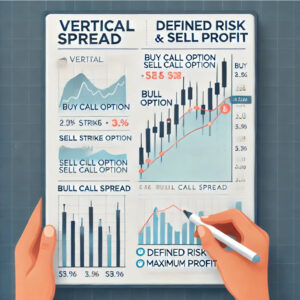Understanding Vertical Spreads in Options Trading: A Beginner's Guide
Types of Vertical Spreads
Vertical spreads can be categorized based on market outlook:
1. Bullish Vertical Spreads: These are used when a trader expects the underlying asset’s price to rise. The two primary bullish vertical spreads are:
-
-
Bull Call Spread: Involves buying a call option at a lower strike price and selling another call option at a higher strike price. Both options have the same expiration date. This strategy limits both potential profit and potential loss.
-
Bull Put Spread: Involves selling a put option at a higher strike price and buying another put option at a lower strike price, with the same expiration date. This strategy also limits potential profit and loss.
-
2. Bearish Vertical Spreads: These are used when a trader anticipates a decline in the underlying asset’s price. The main bearish vertical spreads are
-
-
Bear Call Spread: Involves selling a call option at a lower strike price and buying another call option at a higher strike price, both with the same expiration date. This strategy limits both potential profit and loss.
-
Bear Put Spread: Involves buying a put option at a higher strike price and selling another put option at a lower strike price, with the same expiration date. This strategy also limits potential profit and loss.
-
Defined Risk and Reward
One of the key advantages of vertical spreads is their defined risk and reward profile. By simultaneously buying and selling options, traders set clear boundaries on both potential gains and losses. The maximum potential profit or loss is determined at the outset, making it easier to manage risk.
Example of a Bull Call Spread
Suppose a stock is currently trading at $50, and you anticipate its price will rise over the next month. You could implement a bull call spread by:
-
Buying a call option with a strike price of $50 (lower strike).
-
Selling a call option with a strike price of $55 (higher strike).
Both options have the same expiration date. If the stock’s price rises above $55 by expiration, your maximum profit is achieved. If it stays below $50, your maximum loss is limited to the net premium paid for the spread.
Brokerage Support for Stop Orders on Spreads
Managing risk is crucial in options trading, and the ability to place stop orders on spreads can be an important tool. However, not all brokerages offer this feature. Here’s how some popular platforms handle stop orders on spreads:
-
Interactive Brokers (IBKR): Offers stop and stop-limit orders for options, including complex spreads. Traders can set conditional orders that trigger based on the price movement of the underlying asset.
-
tastytrade: Provides stop-limit orders on multi-leg option spreads across all their technology platforms. However, they do not offer stop-market orders on spreads.
-
Charles Schwab: Allows the use of stop orders to help protect positions, including options spreads. These orders can help obtain a predetermined entry or exit price, limit a loss, or lock in a profit.
-
TradeStation: Offers advanced order types, including stop orders, which can be applied to options strategies. However, the availability of stop orders on spreads may depend on the specific strategy and account settings.
It’s important to note that while some brokerages offer stop orders on spreads, others may not support this feature. Additionally, the functionality and execution of stop orders can vary between platforms. Traders should consult their brokerage’s support resources or contact customer service to understand the specific capabilities and limitations related to stop orders on spreads.
Considerations When Using Stop Orders on Spreads
While stop orders can help manage risk, they also come with certain considerations:
-
Execution Risk: Stop orders become market orders once triggered, which may result in execution at a price different from the stop price, especially in volatile markets.
-
Market Conditions: In fast-moving or illiquid markets, stop orders may not execute at the desired price, leading to slippage.
-
Brokerage Policies: Some brokerages may not support stop orders on certain types of spreads or may have specific requirements for placing such orders.
Conclusion
Vertical spreads are versatile options strategies that allow traders to define their risk and reward parameters. They are particularly useful for those looking to capitalize on directional moves in the market while maintaining a controlled level of risk. Whether you’re using a bull call spread, bull put spread, bear call spread, or bear put spread, the key takeaway is that you have a predefined maximum profit and loss.
Additionally, the ability to set stop orders on spreads can be a crucial tool for managing risk effectively. Some brokerages, like Interactive Brokers, tastytrade, Charles Schwab, and TradeStation, provide stop-order functionality for spreads, while others may not support this feature. Understanding the capabilities of your brokerage is essential when developing a trading strategy that incorporates stops.
As you continue your journey in options trading, learning to effectively utilize vertical spreads and brokerage tools will help improve your risk management and trading success. Stay tuned for future blog posts where we’ll dive deeper into specific strategies that leverage stop orders on spreads to optimize profits and limit downside risk.
If you have any questions or want to see a breakdown of a specific strategy, leave a comment below!
